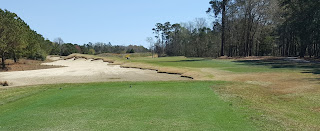GOLF TIP 1 - Check your golf bag:
Our first tip has nothing to do with your swing but, rather, with your golf bag. Your faithful stand bag or cart bag has probably been stored in the garage or in the trunk of your car all season long so give it a thorough going over - check all pockets, remove partially-eaten snacks, old water bottles and pare down on the number of tees you have collected from last year.GOLF TIP 2 - Check Your Equipment:
- The most obvious check is to make sure you only have fourteen golf clubs in your bag.
- Next, check your grips - do any of your clubs need to be regripped?
- Clean your clubs - a shiny set will get you in the right mood to start the season off right. Also, when you clean the clubs, look at the shafts, the head...make sure all clubs are as you left them last season or take them to a qualified professional for adjustment.
GOLF TIP 3 - Driving Range:
- The first thing I would suggest if you are rusty is to get a lesson from a teaching professional - your swing is probably out of alignment and could use an adjustment.
- Don't start off by banging balls on the range with a driver if it is your first time out - instead, start with a wedge and gradually work up to mid-irons.
- Make sure you PUTT and Chip! Putting indoors all winter is nothing like putting on a true green. Roll a few, get the speed down pat and get into the circle of trust. With regards to chipping, get your feel back.
- Think about your tempo and don't rush your swing - consider how wonderful it is to be outside swinging a golf club and hear a song in your mind that reminds you of spring.
Read: More Tips to Spruce Up Your Golf Swing for Spring
GOLF TIP 4 - Set Goals:
- How did you finish last year - did you get into the 90's, were you determined to play better out of bunkers? Set goals that you can achieve early on in the season - write them down and make them a reality!
- You can be a better putter, you can improve your driving distance, you can get better at course management! More daylight, warmer weather...get out onto a range, green or golf course and enjoy the season.
How are you getting ready for spring? Add your tips - Tag us on Twitter @Golf4Beginners and let us know on this golf blog!




